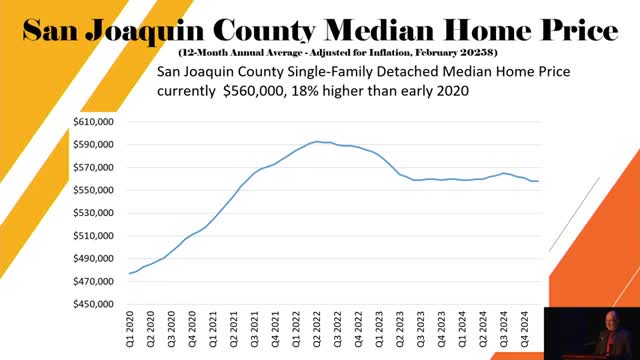San Joaquin County housing prices stabilize after pandemic peak but remain high
March 28, 2025 | Tracy, San Joaquin County, California
This article was created by AI summarizing key points discussed. AI makes mistakes, so for full details and context, please refer to the video of the full meeting. Please report any errors so we can fix them. Report an error »

The State of the City Address delivered on March 25, 2025, by city officials in Tracy, San Joaquin County, highlighted significant trends in housing, commuting patterns, and demographic shifts affecting the region.
A primary focus of the address was the current state of housing costs in Tracy and surrounding areas. The median price for homes in San Joaquin County has stabilized at approximately $560,000, which is still 18% higher than pre-pandemic levels. The speaker noted that while housing prices peaked in mid-2022, they have since leveled off despite rising mortgage rates, which now exceed 6%. Comparatively, the median home price in Alameda County reached $1.52 million, creating a substantial price gap of nearly $930,000 between the two counties.
The address also discussed the impact of the pandemic on migration patterns. Contrary to expectations of increased movement to San Joaquin County due to remote work opportunities, data indicated that many residents left the region entirely for other states. The net domestic migration to San Joaquin County was reported as negative or near zero, suggesting a shift in population dynamics.
In terms of rental costs, rents in Tracy have increased by 24% since January 2020; however, when adjusted for inflation, the real increase is nearly negligible, at just under 1%. The speaker pointed out that while rents in Tracy were historically about 20% higher than the rest of the county, this premium has decreased to 14%.
The address also touched on commuting trends, revealing that 34% of Tracy residents commute over an hour each way to work, significantly higher than national averages. Despite this, public transit ridership has not rebounded as expected, with ACE train service recovering to only 50% of pre-pandemic levels.
Lastly, the address raised concerns about declining birth and fertility rates in San Joaquin County, which could lead to an aging population. Projections indicate a 65% increase in the senior population over the next 25 years, while the younger demographic is expected to decrease by 4%. This demographic shift poses challenges for workforce development and elder care services in the future.
Overall, the address underscored the need for strategic planning to address housing affordability, commuting challenges, and demographic changes as Tracy continues to evolve in the coming years.
A primary focus of the address was the current state of housing costs in Tracy and surrounding areas. The median price for homes in San Joaquin County has stabilized at approximately $560,000, which is still 18% higher than pre-pandemic levels. The speaker noted that while housing prices peaked in mid-2022, they have since leveled off despite rising mortgage rates, which now exceed 6%. Comparatively, the median home price in Alameda County reached $1.52 million, creating a substantial price gap of nearly $930,000 between the two counties.
The address also discussed the impact of the pandemic on migration patterns. Contrary to expectations of increased movement to San Joaquin County due to remote work opportunities, data indicated that many residents left the region entirely for other states. The net domestic migration to San Joaquin County was reported as negative or near zero, suggesting a shift in population dynamics.
In terms of rental costs, rents in Tracy have increased by 24% since January 2020; however, when adjusted for inflation, the real increase is nearly negligible, at just under 1%. The speaker pointed out that while rents in Tracy were historically about 20% higher than the rest of the county, this premium has decreased to 14%.
The address also touched on commuting trends, revealing that 34% of Tracy residents commute over an hour each way to work, significantly higher than national averages. Despite this, public transit ridership has not rebounded as expected, with ACE train service recovering to only 50% of pre-pandemic levels.
Lastly, the address raised concerns about declining birth and fertility rates in San Joaquin County, which could lead to an aging population. Projections indicate a 65% increase in the senior population over the next 25 years, while the younger demographic is expected to decrease by 4%. This demographic shift poses challenges for workforce development and elder care services in the future.
Overall, the address underscored the need for strategic planning to address housing affordability, commuting challenges, and demographic changes as Tracy continues to evolve in the coming years.
View full meeting
This article is based on a recent meeting—watch the full video and explore the complete transcript for deeper insights into the discussion.
View full meeting
